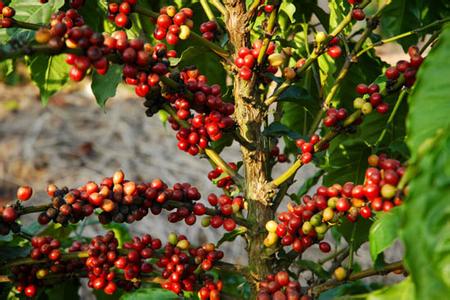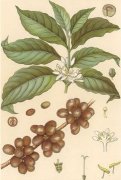Coffee basics two coffee varieties of coffee beans
Linnaeus classified coffee plants in the Rubiaceae family, e.g. Gardenia. The great naturalist named it Coffea.
Although plants in the wild can grow to 10-12 metres tall, those in plantations are about 3 - 5 metres tall, except in Colombia, where few species exceed 2 metres. This makes farming and picking easier and cultivation more economical.
The leaves turn dark green, light green and bronze yellow according to the stage of growth. The flowers are white, clustered and have a fragrance similar to Spanish jasmine. The flowers soon turn red berries, which vary in color depending on the type of plant.
At first glance, the fruit resembles a large cherry in size and color. This berry is enclosed in a sticky pulp (mesocarp) and covered with a thin film (exocarp). The seeds in the flesh are two bean-shaped fruits that are flat together. Each bean is wrapped in a layer of golden parchment called the endocarp.
Stripping the endocarp reveals the real bean, which is coated with another very thin silver film. The beans vary according to species, being blue-green close to bronze, up to 11 mm long and 8 mm wide. Each species has its own variety, and each variety varies in size, color and pest resistance.

species, growth
Today, some of the most important producing countries grow two major coffee varieties: Arabica and Robusta. Grafting from these two species yields several different species, denoted by the name of the country of production.
Coffea Arabica, a valuable variety, has been grown for centuries and accounts for three-quarters of the world's coffee production. As the name implies, it comes from Arabia and thrives on mineral-rich lands, with well-known subspecies being Moka, Maragogipe, San Ramon, Columnaris, and Bourbon. Arabica coffee from Brazil has the common name Brazilian Coffees; Milds from Colombia, Venezuela, Peru, Guatemala, El Salvador, Haiti and Santo Domingo. Arabica coffee is also grown in Africa. Arabica is a full-flavored coffee with a clear taste and lower caffeine content. However, due to the different types of crops, there are also different tastes. Arabica beans look lanky and pale greenish blue.
Coffea Robusta can grow to over 12 meters and up to 600 meters above sea level and grows rapidly, with greater pest resistance. Discovered in Congo in 1898, this robust variety spread widely, especially in Africa, Asia and Indonesia where the climate was not suitable for growing Coffea Arabica. It accounts for a quarter of the world's total production. Due to its higher caffeine content (about twice as high as Arabica) and its strong taste characteristics, Robustas are often used in specialized blends. Overuse and/or incorrect processing results in cheap and bitter coffee with a pronounced "woody feel," a characteristic of natural Robustas from Africa. The washed variety from Indonesia is rarer and more valuable in certain combinations. This bean is smaller in shape, round and yellowish brown.
Coffee crops need special natural environments to thrive and harvest well:
Suitable climate: hot and humid or sub-hot climate areas, between the north and south tropics, rainy, temperatures between 15 and 25℃.
The soil should have a deep, hard, permeable subsoil conducive to irrigation and drainage. The best land is on a hilly hillside, broken down into rocks from volcanic rocks or freshly cultivated forests. The ideal altitude is between 600 and 1200 meters, although some varieties are suitable for 2000-2200 meters, others are suitable for less than 400 meters, or even on flat ground.
Carefully cultivated with the aim of protecting the tree species at each stage of growth, therefore:
Select seeds from robust, productive and long-lived species
Seeds are first planted in sheltered, dark nurseries, and after about six months, seedlings are transplanted to plantations during the rainy season, along with the soil surrounding the roots.
Depending on the region (tropical or subtropical) in which it is grown, coffee trees are protected from high winds and excessive sunlight by other trees. Nurtured and protected in this way, trees will begin to bear fruit when they are three or four years old.
Important Notice :
前街咖啡 FrontStreet Coffee has moved to new addredd:
FrontStreet Coffee Address: 315,Donghua East Road,GuangZhou
Tel:020 38364473
- Prev

Coffee knowledge Coffee tree coffee beans growth habits
Coffee is a drink that gives the public the impression of being black, bitter, sleepless, and excited. The coffee beans we see in coffee shops are dark brown and belong to roasted coffee beans, while the color of coffee liquid is amber. Coffee comes from coffee beans, which in turn are harvested and processed from the fruits of trees. Distribution of coffee: coffee trees
- Next

The basic knowledge of coffee beans the harvest time and treatment of coffee beans
Harvesting and handling harvests take place in different months of the year (depending on the geographical location of the producing country), depending on the maturity of the fruit. The harvest time depends on the geographical location, climate and altitude, and varies according to the situation of each producing country. Ripe fruit can be picked by hand, or raked with a small rake, or hit to the ground with a pole: the first two ways can use low-cost labor
Related
- Beginners will see the "Coffee pull flower" guide!
- What is the difference between ice blog purified milk and ordinary milk coffee?
- Why is the Philippines the largest producer of crops in Liberia?
- For coffee extraction, should the fine powder be retained?
- How does extracted espresso fill pressed powder? How much strength does it take to press the powder?
- How to make jasmine cold extract coffee? Is the jasmine + latte good?
- Will this little toy really make the coffee taste better? How does Lily Drip affect coffee extraction?
- Will the action of slapping the filter cup also affect coffee extraction?
- What's the difference between powder-to-water ratio and powder-to-liquid ratio?
- What is the Ethiopian local species? What does it have to do with Heirloom native species?

